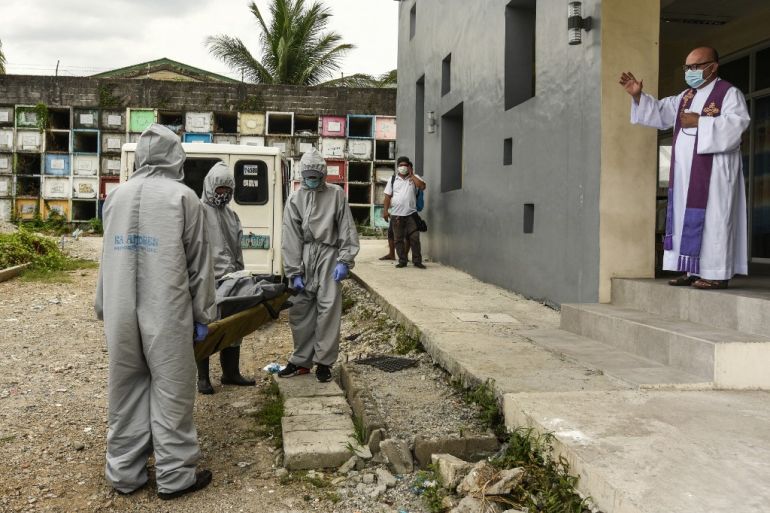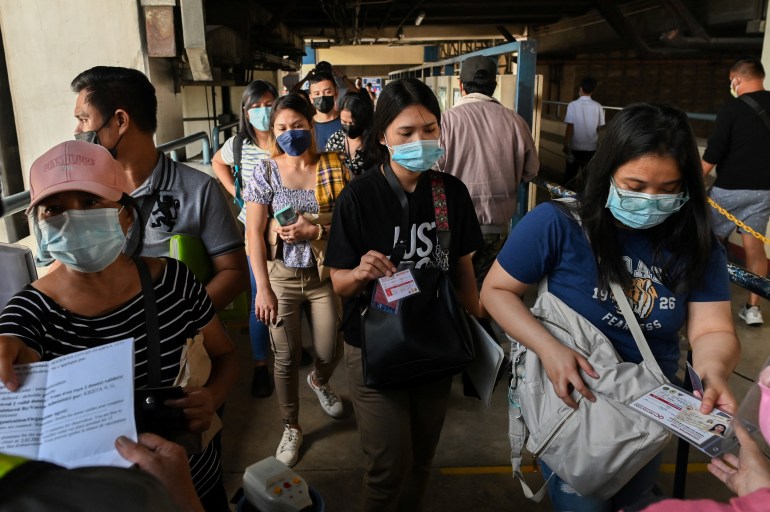Philippine COVID deaths may be double the current number
Statistics office has recorded more than 105,000 total COVID deaths as the country hits a new record for active cases – the highest in Southeast Asia.

Deaths in the Philippines due to the COVID-19 pandemic may be double the health department’s official numbers, according to a new government report, as the country battles a record-breaking wave of the pandemic due to the Omicron variant.
In a preliminary report released on Monday, the Philippine Statistics Authority (PSA) put “registered deaths due to COVID-19” at 75,285 from January to October 2021.
Keep reading
list of 3 itemsPhilippines starts three-day, nine million person COVID jab drive
Philippines eyes ‘unvaccinated list’ amid Duterte’s arrest threat
That number represents more than one-tenth of all deaths reported in the same period in 2021, second only to heart disease.
Combined with the statistics agency’s reported COVID-related deaths of 30,140 in 2020, the cumulative death toll stood at 105,425 as of October 2021 – nearly double the government’s current official figures.
On Monday, the Department of Health (DOH) put COVID-related deaths at a total 52,929 since the first death was reported in the Philippines in February 2020.
The PSA said its figures were based on the descriptions written by health officials on patients’ death certificates.
The health department’s figures are based on its own “surveillance system” – a database of testing and monitoring generally connected to the hospitals and medical facilities for which it is responsible.
Peter Julian Cayton, an associate professor in statistics from the University of the Philippines, says the health department only counts deaths as COVID-related when confirmed by testing, and that it also collected the data more slowly.
“What we tend to see from the data is that deaths reporting by DOH tends to be 30 to 40 days delayed, which tends to get worse during surges,” Cayton told Al Jazeera.
Rise in deaths due to heart disease, diabetes
In its report, the statistics agency explained that its system of reporting inlcudes both confirmed and probable cases as defined by the World Health Organization’s rules on statistical classification.
Confirmed cases are those that have undergone a laboratory test, while suspected or probable cases are “clinically-epidemiologically diagnosed” where testing “was not completed or inconclusive”.
Nearly three-quarters of the COVID-related deaths were reported in Metro Manila as well as its neighbouring provinces in the northern Luzon island.

Aside from COVID, the top causes of death in the Philippines in 2021 included heart diseases, stroke, cancer and respiratory diseases such as tuberculosis.
Deaths due to heart diseases and diabetes showed a sharp increase of 28 percent and 17.5 percent respectively compared with 2020.
On Monday, the health department reported 37,707 new COVID cases – its fourth-highest since the pandemic began – pushing the number of active cases to a new record of nearly 300,000.
Daily cases have been above 30,000 since January 12.
As part of the effort to contain the spread of COVID, President Rodrigo Duterte’s administration on Monday began banning unvaccinated individuals from all public transport within Metro Manila as well as on routes in and out of the sprawling city.
DAILY SNAPSHOT: Total Cases crossed 15.76 million at 7:00 pm with more than 64,000 New Cases reported across Southeast Asia since our last update. #COVID19 #Pandemic #Omicron #ASEAN pic.twitter.com/qRO8mqlL2r
— The ASEAN Post (@theaseanpost) January 17, 2022
GMA television network reported that, on the first day of the implementation of the new rule, even those who were partially vaccinated were denied access to transport.
Duterte had previously said that he will order the arrest of those who are unvaccinated. The government also said that it wants villages to create a list of individuals who have not been vaccinated.
On Tuesday, Duterte’s spokesman Karlo Nograles said during his daily briefing that 55.19 million Filipinos were now fully vaccinated, while 63.8 million had received their first dose.
With the current pace of vaccination, the country is expected to reach its goal of vaccinating 70 percent of the country’s 110 million people by the second week of March.